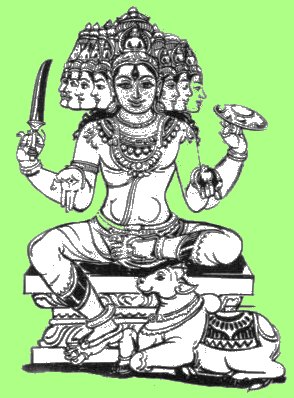



Image used with permission.
Basic Description: The twelve months of the year are the sovereign principles. They move carrying along this whole world, hence they are called leaders. The twelve Aditays are said to be the offspring of Aditi, who is called the mother of the gods. The Adityas always go in pairs and are of even number.
They are represented as the spokes of the wheel of Time. The twelve sovereign principles are generally given as Mitra (solidarity), Varuna (fate), Aryaman (chivalry), Daksa (ritual skill), Bhaga (the inherited share), Amsa (the gods' given share), Tvastr (craftsmanship), Savitr (the magic power of words), Pusan (prosperity), Sakra (courage), Vivasvat (social laws), and Vishnu (cosmic law), however there are a few variants.
Alternate Names: The Adityas are called the twelve sovereign principles
History/Practices:
The Iranians thought thirty-three to be the number of the gods.
Those thirty three gods are divided into eight deities ruling the spheres and the elements, eleven deities of life or the subtle world, and twelve divinities of knowledge or aspects of consciousness, which are the Adityas. They are emblems of the sun for each month of the year; and are themselves called suns. They are embodiments of the laws that rule the universe as well as human society. They dwell in the sky, the higher sphere, and dominate life and the elements. They pre-exist all forms, being the principles according to which the universe is built.
Iconography:
The attributes of the Adityas were two or more lotus.
In the iconography, Varuna is depicted as the rider of a chariot drawn by seven swans, with four hands and an umbrella over his head.
In some images the swans are replaced by a crocodile, suggestive of his lordship over the aquatic life.
Varuna attributes are the conch, lotus, parasol, sacred thread, snake noose, trident, and water jar of jewels. Pusan's
attributes are four lotus. Tvastr's attributes are the homajakalika, an uncertain fire device, a ladle, and two lotus.
Bhaga's attributes are two lotus, prayer wheel, and the trident. Mitra's attributes are two lotus, a trident, and the sacrificial drink or soma.
Vishnu holds a conch shell, a discus, a club, and a lotus flower in his four hands.
Daksa's attribute is the head of a sacrificial goat, which Brahma gave to him.
Mythology:
In the Vinu Purana the father of the twelve sovereign principles is Kasyapa (Vision). When their mother, the Primordial-Vastness (Aditi), daughter of Ritual-Skill, (Daksa), was unable to bear the radiance of her offspring, the father divided the fetus into twelve parts. Each of these gave rise to one of the sovereign principles, which are identified with the months of the year. Varuna watches over humanity with a thousand eyes, and shares responsibility for the sacred order; therefore he is related with the concept of dharma. Later in mythology the god Indra assumes precedent over him, and he is reduced down to the god of death.
It is said that he once ran off with Bhadra, wife of Utathya, but later restored her. He is paid little homage in India today, and the only existing temple dedicated to him is on the island of Bali.
Varuna sometimes appears as the god
of the oceans, in this aspect he is invoked by all intending to take sea
voyages. Vishnu
is portrayed as a young man, blue in color. His riding animal is Garuda,
who is the enemy of all serpants. When Krishna
fought the serpant Kaliya, he told Kaliya that Garuda
would forever spare him since he had been touched by Krishna.
Pusan is also the god of travelers, he protects travelers and their
animals.
Riding Animal: Mitra
sits and rides in a gold-hued chariot in the sky.
Varuna rides upon a fish, Makara or Jalampa the sea monster, or on a chariot driven by seven horses.
Savitr rides the space between heaven and earth in a golden chariot drawn by two horses, banishing disease and tribulation.
Vishnu's riding animal is the sun bird Garuda, enemy of all serpents.
Consort:
Mitra's
wife is Revati (prosperity). The consort of Bhaga is Siddhi (Realization).
Varuna's wife is called either Varunani or Varuni, Gaudi or Gauri, the Fair One, who is the goddess of liquor. He is said to have eloped with Bhadra (Fortunate), the wife of the brahmana Utathya.
Daksa's
consort is Prasuti and he is said to have up to sixty daughters. Vivasvat's
wife is Saranyu (Cloud), Tvastr's daughter. Savitr's wife is Prsni (Ray-of-Light).
Vishnu's consort is Laksmi, the goddess of fortune.
Sources:
Danliélou, Alain. The Myths and Gods of India. Rochester, Vermont: Inner Traditions International, 1991.
Jordan, Michael. Encyclopedia of Gods. New York: Facts On File, Inc. 1993.
Rice, Edward. Eastern Definitions: A Short Encyclopedia of Religions of the Orient. Garden City, New York: Doubleday, 1978.
Thomas, P. Epics, Myths
and Legends of India. Bombay, India: D. B. Taraporevala Sons &
Co. Private Ltd, 1961.



